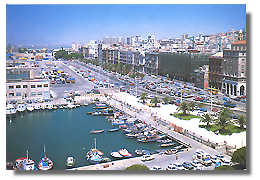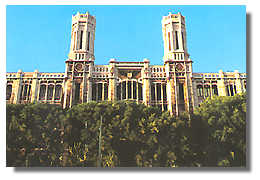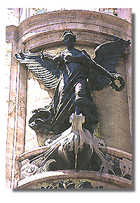
The Marina
neighborhood is characterized by contrast. The silence of the streets near the port
(a web of hills and stairs that open to splendid views of the Santa Gilla lagoon
and the Capoterra mountains) dissolves in the noise of the city's busiest streets,
Largo Carlo Felice and Via Manno. A visit to this area begins with the old sa Costa
(Via Manno), the commercial fulcrum of the city and axis dividing the streets leading
down to the port from those going up towards the bastions.
Monuments:
In the past, the Marina area was home to many religious buildings, some long since
destroyed. The remaining churches provide a fascinating glimpse of the past. In the
alleys leading down to the port, the churches of S.Antonio Abate and Santa Rosalia
are Baroque in style, while San Sepulcro and Sant'Eulalia are Gothic-Catalan in design.
Sant'Agostino, with its monumental interior, is one of the rare examples of Renaissance
ecclesiastical architecture on the island. At the foot of the hill, facing the anchored ships, the long "Liberty Style" (turn-of-the-century Italian Art Nouveau) row of
buildings in Via Roma is interrupted by the Regional Council Hall, by the church
of San Francesco da Paola, and by the City Hall Building. This last was built at
the turn of the century and was faithfully reproduced after its destruction during WWII. Piazza
Yenne (which really belongs to the Stampace neighborhood) and the bronze statue of
the Savoy sovereign are reached after climbing Largo Carlo Felice.
Shopping and points of interest:
Among the established and newer shops, there are also antiques shops with interesting
collectors' items, crafts shops, and restoration workshops. Via Roma and Via Manno
have a different character, befitting more important purchases.

Eating and drinking:
The Marina neighborhood is a gourmet's delight. Specialty shops are located in Via
Sardegna, while family type "trattorie", most of which offer fish, and moderately
priced or more refined restaurants are located in Via Regina Margherita, Via Sardegna,
Via Torino and Via Principe Amedeo. In the streets, the aroma of roasting coffee beans
mingles with the perfume of tobacco from the Manifattura and with the inviting odor
of the fishmongers' shops.
Culture:
In the spaces connected to the church of Sant'Eulalia, a small alternative theater
presents theatrical performances and film projections; in the summer months, they
set up an open air cinema. Behind the church, a small museum exhibits sacred objects
and furnishings dating from 15th-17th centuries. Sardinia's oldest cultural organization,
Amici del Libro
(Friends of the Book), is housed in the City Hall Building in Largo Carlo Felice 2.
Founded in 1944, the organization sponsors lectures, debates, and conferences.
Promenades and open spaces:
All open spaces are near the city's port. In front of the train station near the
Stampace neighborhood, stands a garden with two enormous Ficus magnolioides and large
shade palms. Canary palms line Via Roma's traffic median. The porticos across the
street provide shade for pedestrians heading for Piazza Amendola. The city's original dockyards
have recently been transformed into a garden area whose new planting mixes with the
older monumental trees, their trunks bearing the wounds of the last World War.
|







